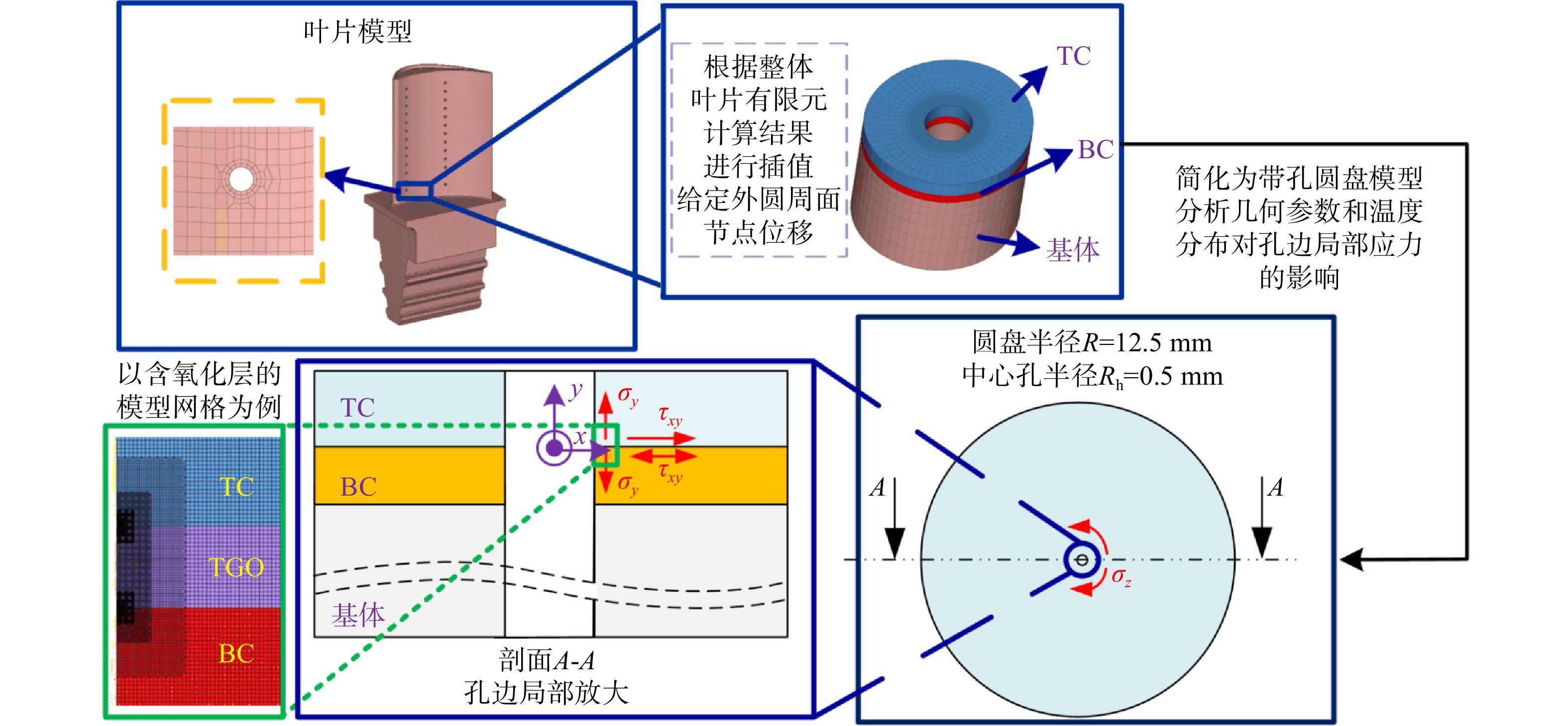Analysis of local stress at hole edge of air-cooled blade with thermal barrier coatings
-
摘要:
基于有限元法计算了热障涂层-基体系统热失配状态下的孔边应力,计算结果表明:涂层界面法向应力和界面切应力集中于孔边,孔边周向正应力较大,孔边涂层容易出现开裂和剥落。计算并分析了陶瓷层厚度、计算模型外径、氧化层厚度、孔径和温度分布对孔边局部应力的影响,结果表明:界面法向应力和界面切应力的作用范围随陶瓷层厚度的增加而增大,叶片冷却孔边应力计算子模型外径应大于4倍陶瓷层厚度与1/2孔径之和;冷却状态下,氧化层厚度的增加会增大界面法向正应力和界面切应力;高温下,孔径越小孔边陶瓷层周向正应力越大;在孔边温度非均匀分布的情况下界面应力和孔边周向正应力会增大。
Abstract:The stress distributions of the thermal barrier coating-substrate system with a hole under thermal mismatch were calculated using finite element method. Calculation results indicated that the interfacial normal/shear stress concentration occurred at the edge of the film hole, and higher circumferential stress existed near the edge of the hole. The coating near the hole edge was prone to cracking and spalling. The effects of the thickness of the ceramic layer, the outer diameter of the model, the thickness of the oxide layer, the hole diameter, and the temperature distribution on the local stress near the hole edge were calculated and analyzed. Results revealed that the region with interfacial normal and shear stress became larger while the thickness of the ceramic layer increased. The outer diameter of the sub-model, which was used to calculate the stress near the edge of the film hole, should be greater than the sum of four times of the ceramic layer’s thickness plus half of the diameter of the hole. Under the cooling condition, the interfacial normal and shear stress increased with the thickness of the oxide layer. At high temperature, the circumferential stress at the edge of the ceramic layer near the hole decreased with the diameter of the hole. The interfacial stress and circumferential stress near the hole edge increased in the case of non-uniform temperature distribution.
-
表 1 热障涂层系统各层材料参数[12]
Table 1. Material parameters of each layer of the thermal barrier coating system[12]
涂层结构
(材料)弹性模量
E/GPa泊松比
ν线膨胀系数
α/(10−6·K−1)TC(YSZ) 48 0.1 9.0 TGO(Al2O3) 400 0.23 8.0 BC(MCrAlY) 200 0.3 13.6 基体
(PWA 1480)184 0.3 12.0 表 2 Δtw=100
$ {{\text{℃}}} $ ,各层径向应力理论解和有限元计算结果对比Table 2. Comparison of the radial stress obtained from analytical method and finite element method respectively while Δtw=100
$ {{\text{℃}}} $ 模型 位置 理论解
σx,a/MPa有限元解
σx,f/MPa$\left(\dfrac{ { {\sigma _{x,{\text{f} } } } - {\sigma _{x,{\text{a} } } } } }{ { {\sigma _{x,{\text{a} } } } } }\right)\Big/\text{%}$ 无氧化层 TC 16.345 16.334 −0.067 BC −43.883 −43.919 −0.082 基体 1.681 1.654 −1.606 有氧化层 TC 16.319 16.304 −0.092 TGO 210.877 210.765 −0.053 BC −44.020 −44.079 0.134 基体 1.556 1.506 −3.213 表 3 1150
$ {{\text{℃}}} $ 下TC层内部径向应力及孔边周向应力的最大值Table 3. Radial stress inside TC layer and maximum value of the circumferential stress near the hole under 1150
$ {{\text{℃}}} $ Htc/μm TC内部径向
应力σx/MPaTC孔边周向应力
最大值σz,max/MPa100 24.90 27.34 200 24.61 32.83 250 24.46 35.26 300 24.31 37.15 400 24.03 39.83 表 4 模型外径不同时应力计算结果及差异对比
Table 4. Comparison of stress calculation results and differences of different model outer diameters
模型
外半径Rt=20 ℃ t=1150 ℃ TC界面法向
正应力最大值
σy,max/MPa法向正应力
差异δσ,n/%TC界面
切应力最大值
τxy,max/MPa切应力
差异δτ/%外圆周面
节点径向位移
sx,o/mmTC层孔边周向
应力最大值
σz,,max/MPa周向正应力
差异δσ,c/%50Htc
(参考值)568.90 77.65 −147.86 35.26 30Htc 568.99 0.02 77.66 0.01 −88.62 35.26 0 10Htc 568.95 0.01 77.65 0 −29.54 35.26 0 6Htc 570.75 0.33 77.80 0.19 −17.72 35.38 0.34 5Htc 573.31 0.78 77.98 0.42 −14.77 35.48 0.62 4Htc 588.31 3.41 78.78 1.46 −11.81 35.33 0.20 表 5 t=1 150
${{\text{℃}}}$ 时,不同TGO厚度下TC层内部径向应力及孔边周向应力最大值Table 5. Radial stress inside TC layer and the maximum value of the circumferential stress in the TC layer near the hole while t
=1 150 ${{\text{℃}}}$ for different thicknesses of TGO layerHtgo/μm TC内部径向应力
σx/MPaTC孔边周向应力
最大值σz/MPa1 24.55 35.26 2 24.48 35.39 3 24.42 35.53 5 24.28 35.79 8 24.09 36.17 表 6 不同孔径时1150
${{\text{℃}}} $ 下陶瓷层内部径向应力及孔边周向应力最大值Table 6. Radial stress inside the TC layer and the maximum value of the circumferential stress in TC layer near the hole under 1150
${{\text{℃}}} $ against the diameter of the holeRh/Htc TC内部径向应力
σx/MPaTC孔边周向应力
最大值σz,max/MPa1 24.49 41.88 2 24.55 35.26 3 24.53 31.74 4 24.43 29.66 -
[1] 邢宇明,谢刚,周志宇,等. 旋转条件下动叶前缘气膜孔排布局数值研究[EB/OL]. [2022-04-19]. https://kns.cnki.net/kcms/detail/11.2297.v.20220328.1247.002.html. [2] MENSCH A,THOLE K A,CRAVEN B A. Conjugate heat transfer measurements and predictions of a blade end wall with a thermal barrier coating[J]. Journal of Turbomachinery,2014,136(12): 1-11. [3] HARDWICKE C U,LAU Y C. Advances in thermal spray coatings for gas turbines and energy generation: a review[J]. Journal of Thermal Spray Technology,2013,22(5): 564-576. doi: 10.1007/s11666-013-9904-0 [4] 张子凡,韩彦冬,王炜哲,等. CMAS渗透下热障涂层界面失效分析[J]. 航空动力学报,2021,36(8): 1702-1711. doi: 10.13224/j.cnki.jasp.20200374ZHANG Zifan,HAN Yandong,WANG Weizhe,et al. Interface failure analysis of thermal barrier coatings under CMAS penetration[J]. Journal of Aerospace Power,2021,36(8): 1702-1711. (in Chinese) doi: 10.13224/j.cnki.jasp.20200374 [5] 刘志远,肖杰,杨丽,等. 涡轮叶片热障涂层隔热性能和应力数值模拟[J]. 湘潭大学学报(自然科学版),2020,42(3): 107-115.LIU Zhiyuan,XIAO Jie,YANG Li,et al. Numerical simulation of thermal insulation performance and stress of thermal barrier coatings on turbine blades[J]. Journal of Xiangtan University (Natural Science Edition),2020,42(3): 107-115. (in Chinese) [6] 王力,王海斗,底月兰,等. 热障涂层应力产生机制及分布特征[J]. 材料导报,2021,35(17): 17143-17149. doi: 10.11896/cldb.20050158WANG Li,WANG Haidou,DI Yuelan,et al. Stress generation mechanism and distribution characteristics in thermal barrier coatings[J]. Materials Reports,2021,35(17): 17143-17149. (in Chinese) doi: 10.11896/cldb.20050158 [7] SUHIR E. An approximate analysis of stresses in multilayered elastic thin films[J]. Journal of Applied Mechanics,1988,55(1): 143-148. doi: 10.1115/1.3173620 [8] SUHIR E. Predicted thermally induced stresses in, and the bow of, a circular substrate/thin-film structure[J]. Journal of Applied Physics,2000,88(5): 2363-2370. doi: 10.1063/1.1286096 [9] JIANG Jishen,MA Xianfeng,WANG Biao. Stress analysis of the thermal barrier coating system near a cooling hole considering the free-edge effect[J]. Ceramics International,2020,46(1): 331-342. doi: 10.1016/j.ceramint.2019.08.267 [10] MENG Zewei,LIU Yongbao,LI Yujie,et al. An analytical model for predicting residual stress in TBC-film cooling system considering non-uniform temperature field[J]. Journal of Applied Physics,2021,129(13): 1-13. [11] JIANG Jishen,WU Di,WANG Weizhe,et al. Fracture behavior of TBCs with cooling hole structure under cyclic thermal loadings[J]. Ceramics International,2020,46(3): 3644-3654. doi: 10.1016/j.ceramint.2019.10.084 [12] ROSLER J,BAKER M,AUFZUG K. A parametric study of the stress state of thermal barrier coatings: Part Ⅰ creep relaxation[J]. Acta Materialia,2004,52(16): 4809-4817. [13] 王铁军,范学领. 热障涂层强度理论与检测技术[M]. 西安:西安交通大学出版社,2016. [14] 杨晓光,耿瑞,熊昌炳. 一种简便的隔热涂层残余应力分析方法及结果讨论[J]. 航空动力学报,1997,12(3): 239-242. doi: 10.13224/j.cnki.jasp.1997.03.004YANG Xiaoguang,GENG Rui,XIONG Changbing. A simple method for calculation of residual stress in thermal barrier coating[J]. Journal of Aerospace Power,1997,12(3): 239-242. (in Chinese) doi: 10.13224/j.cnki.jasp.1997.03.004 [15] ALI M Y,CHEN X,NEWAZ G M. Oxide layer development under thermal cycling and its role on damage evolution and spallation in TBC system[J]. Journal of Materials Science,2001,36(18): 4535-4542. doi: 10.1023/A:1017959509216 [16] HSUEH C H,LUTTRELL C R,LEE S,et al. Interfacial peeling moments and shear forces at free edges of multilayers subjected to thermal stresses[J]. Journal of the American Ceramic Society,2006,89(5): 1632-1638. doi: 10.1111/j.1551-2916.2006.00924.x [17] 董会. 等离子喷涂热障涂层的服役性能[M]. 北京:中国石化出版社,2018. [18] WEE S,DO J,KIM K,et al. Review on mechanical thermal properties of superalloys and thermal barrier coating used in gas turbines[J]. Applied Sciences-Basel,2020,10(16): 1-24. [19] LU Z,MYOUNG S W,KIM E H,et al. Microstructure evolution and thermal durability with coating thickness in APS thermal barrier coatings[J]. Materials Today:Proceedings,2014,1: 35-43. doi: 10.1016/j.matpr.2014.09.009 [20] NAYEBPASHAEE N,SEYEDEIN S H,ABOUTALEBI M R,et al. Finite element simulation of residual stress and failure mechanism in plasma sprayed thermal barrier coatings using actual microstructure as the representative volume[J]. Surface and Coatings Technology,2016,291: 103-114. doi: 10.1016/j.surfcoat.2016.02.028 [21] RABIEI A,EVANS A G. Failure mechanisms associated with the thermally grown oxide in plasma-sprayed thermal barrier coatings[J]. Acta Materialia,2000,48(15): 3963-3976. doi: 10.1016/S1359-6454(00)00171-3 [22] GUPTA M,SKOGSBERG K,NYLEN P. Influence of topcoat-bondcoat interface roughness on stresses and lifetime in thermal barrier coatings[J]. Journal of Thermal Spray Technology,2014,23(1/2): 170-181. -








 下载:
下载:


























